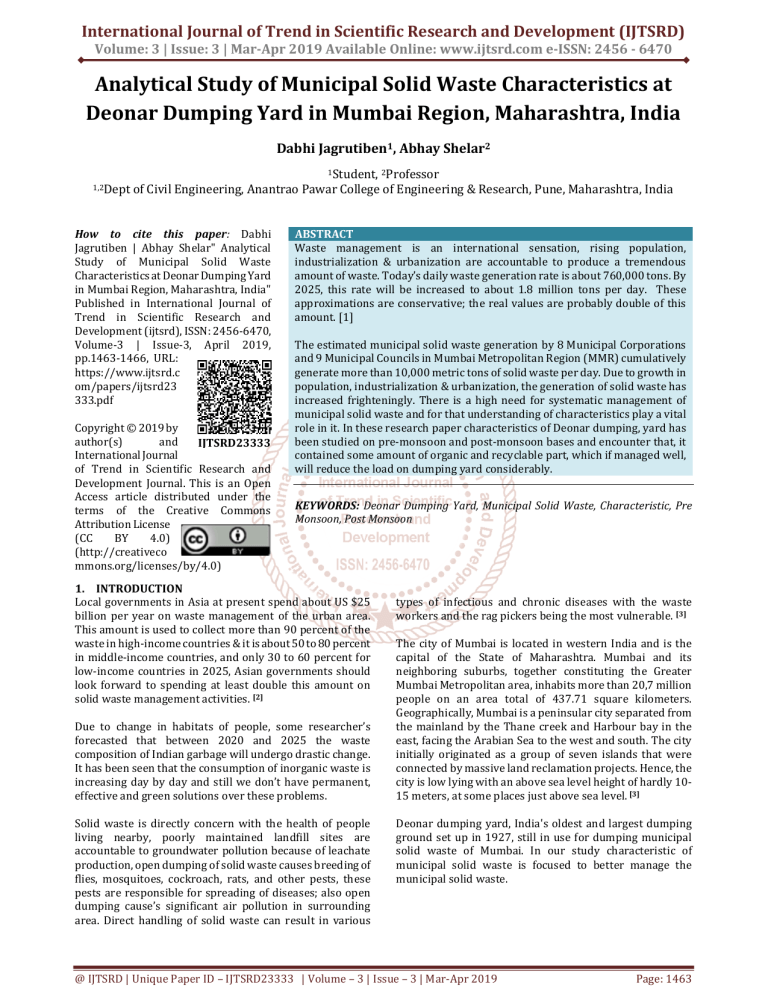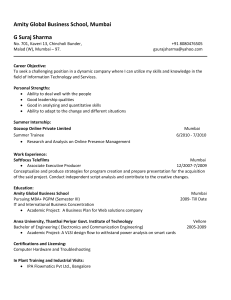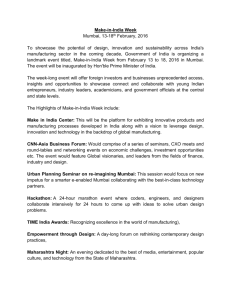
International Journal of Trend in Scientific Research and Development (IJTSRD)
Volume: 3 | Issue: 3 | Mar-Apr 2019 Available Online: www.ijtsrd.com e-ISSN: 2456 - 6470
Analytical Study of Municipal Solid Waste Characteristics at
Deonar Dumping Yard in Mumbai Region, Maharashtra, India
Dabhi Jagrutiben1, Abhay Shelar2
1Student, 2Professor
1,2Dept
of Civil Engineering, Anantrao Pawar College of Engineering & Research, Pune, Maharashtra, India
How to cite this paper: Dabhi
Jagrutiben | Abhay Shelar" Analytical
Study of Municipal Solid Waste
Characteristics at Deonar Dumping Yard
in Mumbai Region, Maharashtra, India"
Published in International Journal of
Trend in Scientific Research and
Development (ijtsrd), ISSN: 2456-6470,
Volume-3 | Issue-3, April 2019,
pp.1463-1466, URL:
https://www.ijtsrd.c
om/papers/ijtsrd23
333.pdf
Copyright © 2019 by
author(s)
and
IJTSRD23333
International Journal
of Trend in Scientific Research and
Development Journal. This is an Open
Access article distributed under the
terms of the Creative Commons
Attribution License
(CC
BY
4.0)
(http://creativeco
mmons.org/licenses/by/4.0)
ABSTRACT
Waste management is an international sensation, rising population,
industrialization & urbanization are accountable to produce a tremendous
amount of waste. Today’s daily waste generation rate is about 760,000 tons. By
2025, this rate will be increased to about 1.8 million tons per day. These
approximations are conservative; the real values are probably double of this
amount. [1]
The estimated municipal solid waste generation by 8 Municipal Corporations
and 9 Municipal Councils in Mumbai Metropolitan Region (MMR) cumulatively
generate more than 10,000 metric tons of solid waste per day. Due to growth in
population, industrialization & urbanization, the generation of solid waste has
increased frighteningly. There is a high need for systematic management of
municipal solid waste and for that understanding of characteristics play a vital
role in it. In these research paper characteristics of Deonar dumping, yard has
been studied on pre-monsoon and post-monsoon bases and encounter that, it
contained some amount of organic and recyclable part, which if managed well,
will reduce the load on dumping yard considerably.
KEYWORDS: Deonar Dumping Yard, Municipal Solid Waste, Characteristic, Pre
Monsoon, Post Monsoon
1. INTRODUCTION
Local governments in Asia at present spend about US $25
billion per year on waste management of the urban area.
This amount is used to collect more than 90 percent of the
waste in high-income countries & it is about 50 to 80 percent
in middle-income countries, and only 30 to 60 percent for
low-income countries in 2025, Asian governments should
look forward to spending at least double this amount on
solid waste management activities. [2]
Due to change in habitats of people, some researcher’s
forecasted that between 2020 and 2025 the waste
composition of Indian garbage will undergo drastic change.
It has been seen that the consumption of inorganic waste is
increasing day by day and still we don’t have permanent,
effective and green solutions over these problems.
Solid waste is directly concern with the health of people
living nearby, poorly maintained landfill sites are
accountable to groundwater pollution because of leachate
production, open dumping of solid waste causes breeding of
flies, mosquitoes, cockroach, rats, and other pests, these
pests are responsible for spreading of diseases; also open
dumping cause’s significant air pollution in surrounding
area. Direct handling of solid waste can result in various
types of infectious and chronic diseases with the waste
workers and the rag pickers being the most vulnerable. [3]
The city of Mumbai is located in western India and is the
capital of the State of Maharashtra. Mumbai and its
neighboring suburbs, together constituting the Greater
Mumbai Metropolitan area, inhabits more than 20,7 million
people on an area total of 437.71 square kilometers.
Geographically, Mumbai is a peninsular city separated from
the mainland by the Thane creek and Harbour bay in the
east, facing the Arabian Sea to the west and south. The city
initially originated as a group of seven islands that were
connected by massive land reclamation projects. Hence, the
city is low lying with an above sea level height of hardly 1015 meters, at some places just above sea level. [3]
Deonar dumping yard, India's oldest and largest dumping
ground set up in 1927, still in use for dumping municipal
solid waste of Mumbai. In our study characteristic of
municipal solid waste is focused to better manage the
municipal solid waste.
@ IJTSRD | Unique Paper ID – IJTSRD23333 | Volume – 3 | Issue – 3 | Mar-Apr 2019
Page: 1463
International Journal of Trend in Scientific Research and Development (IJTSRD) @ www.ijtsrd.com eISSN: 2456-6470
A. Necessity of solid waste management
Due to growth in population, industrialization &
urbanization, the generation of solid waste has
increased threateningly.
Solid waste has many severe influences over the
development of a city or village.
Diseases, odor pollution, unhygienic surrounding are the
major fears arise due to solid waste.
Major cities in India are producing more than 1000
tonnes per day of solid waste. A major part of this waste
is discarded to land dumping which has its own impacts
over land, society, and environment.
Proper SWM provides competence of collection,
segregation, transportation, & treatment of waste
suitably.
This reduces odor pollution & risk of diseases, also good
management improves the aesthetics of the city.
If not managed appropriately then the concept of a
smart city can worsen the situation of the current SWM
scenario.
Though SWM is complex to execute but with
appropriate analysis & study, disciplinary work, and
modern eco-friendly techniques. It is possible to achieve
needful.
B. Study Objective
“The ultimate aim of this work is, to study the characteristics
of solid waste at Deonar dumping yard by conducting the
analytical study in Pre-monsoon and Post-monsoon period”
2. LITERATURE REVIEW
A literature review of scholarly articles, books, dissertations,
conference proceedings and other resources which are
relevant to the study and understanding the characteristics
of municipal solid waste and its methodologies is carried out
to set the background on what has been explored on the
topic so far. An extensive literature review provides
background information on current knowledge related to the
research topic. On the bases of learning from the literature
review, the methodology will be secure and study will be
carried out as per the roadmap derived from the review.
The composition percentage derived from various research
papers is formulated in tabular form below
Table No. 1: Composition Percentage from Various Research Paper
Sr.
No.
Tittle
Year of
Publication
1.
Existing Situation of Solid Waste Management in Pune City,
India by Mane T.T. and Hingane Hemalata N. [12]
2012
2.
Extract from the report “Strategic Action Plan for Integrated
Solid Waste Management Plan
(Volume I)”
2006
3.
Revised city development plan - 2041, Maharashtra, under
JNNURM (Report by PMC)
(Source: https://pmc.gov.in/sites/default/files/projectglimpses/City_Development_Plan)
2013
4.
Integrated solid waste management (Energy revolution from
municipal solid waste) - Report prepared by Solid Waste
Management department of PMC. (Source:
http://opendata.punecorporation.org/Citizen/CitizenDatasets)
2016
5.
Urban Solid Waste Management in Mumbai by Yuri Joelsson
and Rebecca Lord
2016
@ IJTSRD | Unique Paper ID - IJTSRD23333 | Volume – 3 | Issue – 3 | Mar-Apr 2019
Remarks
Composition of
Percentage
Solid Waste
(%)
Organic Waste
70
Paper
8
Plastic
7
Metal
4
Glass
6
Miscellaneous
5
Organic Waste
65
Paper
8
Plastic, Rubber,
7
Leather & Synthetic
Metal
6
Glass
4
Inert material
10
Organic Waste
33
Paper
6
Plastic
5
Metal
3
Glass
5
Inert material
25
Leather/ Rubber
1
22
Miscellaneous
Organic Waste
Paper
Plastic
Metal
Glass
Inert material
Leather/ Rubber
Miscellaneous
Organic Waste
Paper
Plastic
Metal
Glass
31
6
9
3
5
23
1
22
62
17
21
Page: 1464
International Journal of Trend in Scientific Research and Development (IJTSRD) @ www.ijtsrd.com eISSN: 2456-6470
3. METHODOLOGY
In laboratory sorting of material, cleaning of
contamination and air dried. Durable items such as glass
or plastic container can be washed prior to air drying
and filled containers can be emptied of their contents.
Further in the process waste is classified into twelve
categories and then separating all materials as per
categories & weight is measured of each category and
recording the same.
Figure No. 1: Overall Methodology
4. DATA COLLECTION AND RESULT ANALYSIS
Mumbai is also known as dream city and the largest city in
India has a population of about 18.5 million. Mumbai
comprises two regions, the city district which covers an area
of 233 square miles and the more extensive Mumbai
metropolitan area with a total area of 1681.5 square miles.
The city generates 12000 to 13000 tons of solid waste every
day.
The characteristics of Deonar dumping yard is studied in
Post monsoon and Pre-monsoon analysis.
4.1. Post Monsoon analysis of waste
For the post-monsoon analysis, solid waste samples have
been collected in the month of June- July 2018 from various
locations of Deonar dumping as mentioned in methodology.
A. Composition of solid waste
Waste composition studies are essential tools for municipal
solid waste management. The composition of Mumbai solid
waste (as per the report of Solid waste department of BMC)
consist about (35 to 40) % of organic matter. Mumbai solid
waste consists recyclable about (40 to 45) % and the inert
material like dust and construction waste is about (10-15) %
of total waste. As Mumbai is known for one of the best
educational institutes, it consists about 4 % of paper waste.
With rapid urbanization of Mumbai, the percentage of plastic
is changing and consist about 10 % of total waste and
increase in standard of living of Mumbai city the waste
composition of metal and glass is about 3 % and 5 %
respectively.
B.
Sampling Details:
Methodology of Sampling: Manual Sampling
Quantity of sampling: 10 Numbers of samples.
Weight of each sample: 1000 grams
Device used: Sampler Collector, weighing machine
Precautionary measures:
a. Safety mask
b. Hand gloves
c. Gum boots
Place of sampling: Random sampling from the recently
dumped garbage.
C. Analysis Procedure:
These samples are collected in polythene bags
(Recyclable) & transported to the laboratory for further
analysis.
D. Result Discussion
The primary finding of the sampling is that more than 50 %
of waste is organic in nature, the food scrap consists of about
36 % and the yard trim is about 9 %. This high potential of
biodegradable waste shows the potential for composting.
The recyclable composition consists of about 23% at every
place which shows the need for segregation at source.
Among the recyclable plastic waste contributes the highest
as compared with other recyclable waste.
Food Scrap
Yard Trim
Wood
5
2
4
4
8
4
36
Rubber/
Leather
Textile
Plastic
9
Metals
7
5
7
9
Glass
Paper
Dust
Constructio
n Waste
Others
Figure No. 2: Chart showing waste constituents for
Composition in Post Monsoon analysis
4.2. Pre Monsoon analysis of waste
For the pre-monsoon analysis, solid waste samples have
been collected in the month of March-April 2019 from
various locations of Deonar dumping and at various places as
mentioned in methodology. The sampling details and
analysis procedure are the same as post monsoon analysis.
A. Result Discussion
The primary finding of the sampling is about 48 % waste is
organic in nature, the food scrap consists of about 33 % and
the yard trim is about 8 %. This high potential of
biodegradable waste shows the potential for composting.
The recyclable composition consists of about 28 % at every
place which shows the need for segregation at source.
Among the recyclable plastic waste contributes the highest
as compared with other recyclable waste. As per the
examination of samples, it has been observed that the dust
has been increased drastically in some of the samples.
@ IJTSRD | Unique Paper ID - IJTSRD23333 | Volume – 3 | Issue – 3 | Mar-Apr 2019
Page: 1465
International Journal of Trend in Scientific Research and Development (IJTSRD) @ www.ijtsrd.com eISSN: 2456-6470
of Environmental Research And Development Vol. 9
No. 04, April – June 2015)
[2] What a waste, solid waste management in Asia by
Urban Development Sector Unit East Asia and Pacific
Region May 1999.
[3] Urban Solid Waste Management in Mumbai Current
challenges and future solutions for Urban Development
by Prof. Björn Frostell, Ph.D. Student Jagdeep Singh &
Prof. Anurag Garg.
[4] Solomon Cheru, Assessment of Municipal Solid Waste
Management Service in Dessie Town, Addis Ababa
University, School Of Graduate Studies, June, 2011.
[5] Lecture Notes for Environmental and Occupational
Health Students, Takele Tadesse, University of
Gondar2004In collaboration with the Ethiopia Public
Health Training Initiative, The Carter Center, the
Ethiopia Ministry of Health, and the Ethiopia Ministry
of Education.
Figure No. 3: Chart showing waste constituents for
Composition in Pre Monsoon analysis
5. CONCLUSION
Solid waste management is one of the challenging threats in
front of the world, the change in habitats of people, rapid
development is responsible for the large generation of waste,
in Mumbai are generating more than 7,500 MT of waste per
day. This waste is creating problems to public health,
drainage, aesthetics, of the cities, Proper collection, storage,
processing, transport & disposal of waste will lead to the
minimization of waste impacts.
Deonar dumping yard receives 50 - 60 percent of the total
waste generated in Mumbai as this is the largest of all the
three dumping sites with an area of 111 hectares. Presently
the study of Deonar landfill facility for disposal of waste
which is not efficiently working.
The waste generated from the city has a particular character;
the waste from the city is besides organic one, it also
contained some amount of recyclable inorganic part. As per
the keen examination of all samples, it has been observed
that the values of composition are different in all the
randomly selected places. As there is “no one size fits all” and
there is always a scope for improvement and learning, which
gives the scope for advanced study of municipal solid waste
on a larger scale at Deonar dumping yard, with addition of
cement, soil etc. to observe the strength gain is the future
scope of study.
REFERENCE
[1] Analytical Study of Solid Waste Management in Pune,
India By Mane T. T. and Hingane Hemalata N. (Journal
[6] Daniel Hoornweg and Perinaz Bhada-Tata,what a
waste, A Global Review of Solid Waste Management
March 2012, No. 15.
[7] Experimental evidence of anisotropy in municipal solid
waste by D. Zekkos , University of Michigan, Ann Arbor,
USA. Coupled Phenomena in Environmental
Geotechnics – Manassero et al (Eds) © 2013 Taylor &
Francis Group, London, ISBN 978 1 138 00060 5
[8] Comparative Analysis of Solid Waste Management in
20 cities By David C. Wilson, Ljiljana Rodic, Anne
Scheinberg, Costas Velis and Graham Alabaster.
Department of Civil and Environmental Engineering,
Imperial College, London, United Kingdom,
Wageningen University and Research Centre,
Wageningen, the Netherlands, WASTE, Gouda, the
Netherlands; UN-Habitat, Nairobi, Kenya.
[9] Problems of Solid Waste Management in Indian Cities
By Vijay Kumar, Dr R.K.Pandit Professor, Faculty of
Architecture and Planning D.C.R. University of Science
and Technology, Murthal, Sonepat , Haryana Professor,
Department of Architecture, M.I.T.S Gwalior.
[10] Existing Situation of Solid Waste Management in Pune
City, India by Mane T.T.1 and Hingane Hemalata N.
Department of Botany, Baburaoji Gholap College,
Sangvi, Pune, MS, India and Shree Vinay Engg. Services
Pvt. Ltd. working site Tata Motors Pvt. Ltd. Pimpri
Pune, MS, India.
[11] Pune’s Solid Waste Management By Mr. Rajendra
Jagtap and Prof. Dr. Mahesh V. Shitole (Tactful
Management Research Journal - ISSN: 2319-7943).
[12] Status and challenges of municipal solid waste
management in India: A review by Rajkumar Joshi and
Sirajuddin Ahmed, published in Cogent Environmental
Science (2016), 2: 1139434
@ IJTSRD | Unique Paper ID - IJTSRD23333 | Volume – 3 | Issue – 3 | Mar-Apr 2019
Page: 1466





